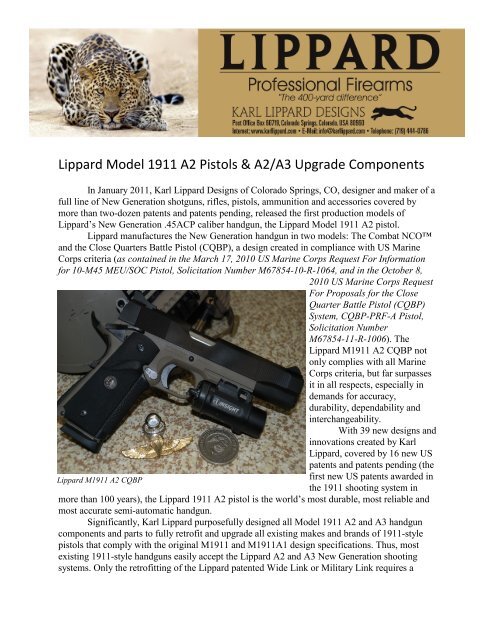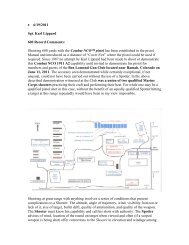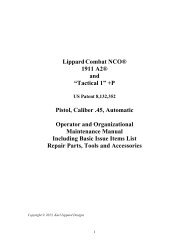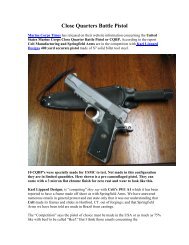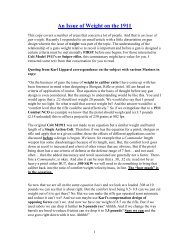Lippard Model 1911 A2 Pistols & A2/A3 Upgrade ... - Karl Lippard
Lippard Model 1911 A2 Pistols & A2/A3 Upgrade ... - Karl Lippard
Lippard Model 1911 A2 Pistols & A2/A3 Upgrade ... - Karl Lippard
- No tags were found...
Create successful ePaper yourself
Turn your PDF publications into a flip-book with our unique Google optimized e-Paper software.
<strong>Lippard</strong> <strong>Model</strong> <strong>1911</strong> <strong>A2</strong> <strong>Pistols</strong> & <strong>A2</strong>/<strong>A3</strong> <strong>Upgrade</strong> ComponentsIn January 2011, <strong>Karl</strong> <strong>Lippard</strong> Designs of Colorado Springs, CO, designer and maker of afull line of New Generation shotguns, rifles, pistols, ammunition and accessories covered bymore than two-dozen patents and patents pending, released the first production models of<strong>Lippard</strong>’s New Generation .45ACP caliber handgun, the <strong>Lippard</strong> <strong>Model</strong> <strong>1911</strong> <strong>A2</strong> pistol.<strong>Lippard</strong> manufactures the New Generation handgun in two models: The Combat NCOand the Close Quarters Battle Pistol (CQBP), a design created in compliance with US MarineCorps criteria (as contained in the March 17, 2010 US Marine Corps Request For Informationfor 10-M45 MEU/SOC Pistol, Solicitation Number M67854-10-R-1064, and in the October 8,2010 US Marine Corps RequestFor Proposals for the CloseQuarter Battle Pistol (CQBP)System, CQBP-PRF-A Pistol,Solicitation NumberM67854-11-R-1006). The<strong>Lippard</strong> M<strong>1911</strong> <strong>A2</strong> CQBP notonly complies with all MarineCorps criteria, but far surpassesit in all respects, especially indemands for accuracy,durability, dependability andinterchangeability.With 39 new designs andinnovations created by <strong>Karl</strong><strong>Lippard</strong>, covered by 16 new USpatents and patents pending (the<strong>Lippard</strong> M<strong>1911</strong> <strong>A2</strong> CQBPfirst new US patents awarded inthe <strong>1911</strong> shooting system inmore than 100 years), the <strong>Lippard</strong> <strong>1911</strong> <strong>A2</strong> pistol is the world’s most durable, most reliable andmost accurate semi-automatic handgun.Significantly, <strong>Karl</strong> <strong>Lippard</strong> purposefully designed all <strong>Model</strong> <strong>1911</strong> <strong>A2</strong> and <strong>A3</strong> handguncomponents and parts to fully retrofit and upgrade all existing makes and brands of <strong>1911</strong>-stylepistols that comply with the original M<strong>1911</strong> and M<strong>1911</strong>A1 design specifications. Thus, mostexisting <strong>1911</strong>-style handguns easily accept the <strong>Lippard</strong> <strong>A2</strong> and <strong>A3</strong> New Generation shootingsystems. Only the retrofitting of the <strong>Lippard</strong> patented Wide Link or Military Link requires a
minor cut in the well of thelower receiver to accept the<strong>Lippard</strong> Link. All other<strong>Lippard</strong> <strong>A2</strong> and <strong>A3</strong> partseasily drop in.In shooting tests firedfrom a Ransom Rest, the<strong>Lippard</strong> Combat NCO, the<strong>Lippard</strong> Close Quarters BattlePistol and other brands of<strong>1911</strong>-type pistols upgradedwith the <strong>Lippard</strong> <strong>A2</strong>/<strong>A3</strong>operating system consistentlyheld shot groups within 13-inch groups at a range of 200yards. The <strong>Lippard</strong> <strong>1911</strong> <strong>A2</strong> isdesigned to shoot at ranges out<strong>Lippard</strong> M<strong>1911</strong> <strong>A2</strong> Combat NCOto 400 yards with its patentedopen sights, shooting consumer common 230 grain .45 ACP ammunition. At typical, close pistolranges, 15, 25 and 50 yards, the<strong>Lippard</strong> Combat NCO and CloseQuarters Battle Pistol rival even thebest-made match pistols.<strong>Lippard</strong> M<strong>1911</strong> <strong>A2</strong> Close Quarters Battle Pistol showing <strong>Lippard</strong>patented sights (calibrated for ranges out to 400 yards), <strong>Lippard</strong>patented ambidextrous thumb safety and jam-proof, patented<strong>Lippard</strong> Belleau-Wood grip safety, and the <strong>Lippard</strong> Cam-Nemagazine.Page 2 of 10These guns, as well as all other<strong>Lippard</strong> Professional Firearms, arefully Made in the USA of a unique<strong>Lippard</strong> proprietary alloy of S7 toolsteel that is highly resistant to rust orcorrosion, extremely strong and doesnot move from tolerances even whenheated or cooled to extremetemperatures. Thus the CombatNCO and Close Quarters BattlePistol will fully function intemperatures as high as 2,700 degreesFahrenheit or as low as minus-78degrees Fahrenheit.Mined and smelted in theUSA, the steel used to make <strong>Lippard</strong>Professional Firearms, componentsand parts is produced in a vacuum-arcremelt process, and then hammerforged into steel billets before being
cut by the latest Computer Numerical Control (CNC) machine technology. <strong>Lippard</strong> uses no castparts or components in any <strong>Lippard</strong> Professional Firearm.Once cut and finished, the firearms components are then hardened to HRC-44-46Rockwell. Axes, chisels, machine tools and the like are typically hardened from HRC-40 toHRC-45. As such, most cutting tools are not able to even scratch a <strong>Lippard</strong> steel firearmcomponent, once finished and hardened.Because of the high quality, strength and durability of this steel, and its nature to neverwarp or move from its tolerances, even when heated or cooled, all <strong>Lippard</strong> Professional Firearmsare fully interchangeable. Furthermore, because of its exact tolerances, the <strong>Lippard</strong> componentsfit more perfectly than even the best custom components made by other gun makers and handfittedby a gunsmith. <strong>Lippard</strong> Professional Firearms are the world’s only fully interchangeablefirearms. Therefore, anytime a part or component is replaced or upgraded on a <strong>Lippard</strong> gun, thenew part merely “drops in.”The <strong>Lippard</strong>Combat NCO is madeto the most demandingtolerances of any pistol inthe world, only 0.003thousandths variance inthe entire gun’s operatingsystem, compared to0.028 thousandthsvariance in even the mostprecision made mil-spec<strong>1911</strong> pistol. The <strong>Lippard</strong>Close Quarters BattlePistol is likewisedesigned and made toexact mil-spec tolerances.Until this time,<strong>Karl</strong> <strong>Lippard</strong> had been<strong>Lippard</strong> Combat NCO disassembled into basic componentscustom making his NewGeneration .45 ACP Combat NCO pistols, using off-the-shelf, military specification basecomponents refitted to incorporate <strong>Lippard</strong>’s patented design innovations, and incorporating hismultitude of newly patented design parts. From about 2007 until the spring of 2010, <strong>Lippard</strong> soldthese custom-made handguns per special orders. Like today’s production of <strong>Lippard</strong> <strong>Model</strong> <strong>1911</strong><strong>A2</strong> pistols, all of the custom handguns are also Unconditionally Guaranteed for Life. Thesecustom guns represented the prototypical design evolution of what has become the <strong>Model</strong> <strong>1911</strong><strong>A2</strong> pistol that <strong>Lippard</strong> manufactures today in its current limited mass production.All of the early edition, custom-made Combat NCO pistols remain in service todaywithout complaint from any of their owners. Some of these early guns represent test-bed guns,and after more than 25,000 rounds of shooting and even abusive handling, none of them showany wear. None of the guns have required any kind of repair or refitting, except for re-bluing, yetPage 3 of 10
they operate and hold extremely accurate shot groups at all ranges, no different than the brandnew production guns manufactured today by <strong>Lippard</strong>.While the early models of the <strong>Lippard</strong> M<strong>1911</strong> <strong>A2</strong> Combat NCO continue to performwell, the New Generation <strong>Lippard</strong> <strong>A2</strong> production guns have even more to offer consumers andprofessionals, as the pistols have evolved forward in design.Major <strong>Lippard</strong> <strong>A2</strong> and <strong>A3</strong> design innovations include:<strong>Lippard</strong> <strong>A3</strong> Sear and Hammer–Perhaps the greatest step forward in fine triggercontrol and firearms safety is <strong>Karl</strong> <strong>Lippard</strong>’s invention and production of thepatented <strong>Lippard</strong> <strong>A3</strong> Sear and Hammer firing system. The New Generationfiring system is applicable to all firearms that employ a sear and hammer firingmechanism. The patented <strong>Lippard</strong> <strong>A3</strong> Sear andHammer firing system is the first change ofsignificance in any mechanical firing mechanism sincethe invention of the Bow and Arrow. Until the adventof the <strong>Lippard</strong> <strong>A3</strong> Sear and Hammer, all firearm searsheld their respective hammers in the cocked positionuntil trigger pressure exerted on the opposite end of thesear dragged the sear from under the sear-ledge on thehammer, allowing the hammer to fall and strike thefiring pin, flint striker orpercussion cap. Theprinciple worked the samewhether a rifle bolt,exposed hammer or hiddenhammer. It is no differentfrom the trigger releasingthe sear holding the stringof a crossbow, or the humanfingers acting as a searholding the bow string on abow and arrow. All smallarms, from muskets andflintlocks to modern riflesTypical <strong>1911</strong>A1 Searand pistols fired on thatsame principle. Thatfundamental operation nowchanges with the advent of the New Generation, <strong>Lippard</strong> <strong>A3</strong> Sear and Hammer.With the <strong>A3</strong> Sear, a cam point at the pivot/balance point of the <strong>A3</strong> Sear engagesthe <strong>A3</strong> Hammer at a directly opposing cam point, lifting the <strong>A3</strong> Hammer awayfrom the <strong>A3</strong> Sear, thus eliminating the relationship of the hammer’s sear-ledgeand the tip of the sear as the firing point, or point of release to fire. The sear-ledgeConventional Sear and Hammer relationship illustrated withthe patented <strong>Lippard</strong> <strong>A2</strong> Sear and typical<strong>1911</strong>A1 Hammer.Page 4 of 10
and sear relationship thus act only as a safe holding point for the hammer whencocked and ready to fire. The <strong>Lippard</strong> <strong>A3</strong> Sear and Hammer will not allow anyfirearm to accidently discharge by the sear falling off the sear ledge, such as in anaccidental drop, because of the substantial sear ledge employed on the <strong>A3</strong>, 0.022thousandths of an inch, well inside the envelope of what most firearms expertsconsider safe (greater than 0.018 thousandths of an inch). Trigger pull on a 0.022thousandths sear ledge on atypical M<strong>1911</strong>A1 pistolwould normally fall wellwithin the five-to- sixpoundrange, when thesprings controlling therelationship of trigger,disconnector, sear andhammer are correctlyadjusted. Most <strong>1911</strong> pistolconsumers andprofessionals, however,want a much nicer andlighter trigger. The <strong>Lippard</strong><strong>A3</strong> Sear and Hammer firingsystem employing what<strong>Karl</strong> <strong>Lippard</strong> has termed the“Anvil and Fulcrum”release, allow cam points meeting at the center of balance/pivot point to lift thehammer away from the sear, achieving a very clean and nice feeling 3.5-pound to4-pound trigger. For most people who have shot a <strong>1911</strong> pistol of any make,employing the <strong>Lippard</strong> <strong>A3</strong> Sear and Hammer, say that it feels more like a 2.5-pound trigger, because of the positive connection with no drag. Some competitiveshooters, firearms professionals, consumers and even gunsmiths will attempt tolighten and improve trigger pull on a <strong>1911</strong> pistol by trimming off the sear ledgeand lightening the firing mechanism’s spring resistance. If the sear ledge isreduced to less than 0.018 thousandths the gun is then vulnerable to accidentaldischarge with a mere bump or shallow drop. Today, this event is becomingcommon. Many high-end <strong>1911</strong> handguns have come to <strong>Lippard</strong> for service withsear ledges cut to 0.014 thousandths and less. One high-end, very expensive pistolhad its sear ledge trimmed to only 0.011 thousandths. Such shortened sear ledgespresent a high risk of accidental firing, even when only slightly jarred. Some suchguns have even begun firing full automatic because of the lack of adequate searledge to stop the hammer action. The <strong>Lippard</strong> <strong>A3</strong> Sear and Hammer now make alight trigger and safe gun available to all consumers and professionals. And it istamper proof!New Generation <strong>Lippard</strong> <strong>A3</strong> Sear and Hammer illustrates theAnvil and Fulcrum release, allowing the opposing cam pointsto lift the <strong>A3</strong> Hammer from the <strong>A3</strong> Sear when firing.Page 5 of 10
<strong>Lippard</strong> Link–Awarded two US patents [US Patent 7,673, 553 B2 - March 9,2010 (Pistol) and- US. Patent 7,861, 640 B2 - January 4, 2010]. The <strong>Lippard</strong>Link comes in two styles, the Wide Link and the Military Link. The Wide Linkis the prototypical <strong>Lippard</strong> Link, first conceived by <strong>Karl</strong> <strong>Lippard</strong> in 1988, and ledto his development of themore functional andadaptable Military Link,developed in 2008. Todaythe Wide Link is consideredvirtually obsolete by<strong>Lippard</strong>, and is rarely used,only when a gun and barrelfit far outside of normalspecifications. The MilitaryLink is the latest Linkdesign from <strong>Karl</strong> <strong>Lippard</strong>,and is standard on all<strong>Lippard</strong> New GenerationM<strong>1911</strong> <strong>A2</strong>/<strong>A3</strong> handguns,including the <strong>Lippard</strong>M<strong>1911</strong> <strong>A2</strong> Combat NCOand <strong>Lippard</strong> M<strong>1911</strong> <strong>A2</strong>Close Quarters Battle Pistol.The Military Link retrofitsnearly all existing barrelsand typical <strong>1911</strong> guns madePatented <strong>Lippard</strong> Barrel Links–Upper Left is the <strong>Lippard</strong>patented Wide Link, rarely used except on barrels far out ofspecification, considered now obsolete by <strong>Lippard</strong>. Center isthe <strong>Lippard</strong> Military Link, which fits most <strong>1911</strong> barrels and isthe normal <strong>Lippard</strong> Link used when upgrading another makeof <strong>1911</strong> handgun. The Military Link is <strong>Lippard</strong>’s state-of-theartlink, standard on all <strong>Lippard</strong> New Generation M<strong>1911</strong> <strong>A2</strong>pistols including the Combat NCO and Close QuartersBattle Pistol. Right is the standard <strong>1911</strong> barrel and narrowlink, typical of all other <strong>1911</strong> style pistols made today.today. The <strong>Lippard</strong> Military Link is designed to accommodate positive lockup ofthe barrel lugs into the upper receiver (slide), providing a solid shooting platform,top and bottom. Most importantly, the <strong>Lippard</strong> MilitaryLink fully stops all side to side play of the barrel duringfiring and cycling, typically found in all other <strong>1911</strong>handguns using the standard “bicycle-style” narrowlink. It is this energy vortex, which sends lateralpressure to the sides of a <strong>1911</strong> pistol during firing thattends to spread the slide from the frame. Over time,with each round fired, the typical <strong>1911</strong> pistol becomesmore and more loose fitting, and the variance in shotgroups grows larger and larger. Both the <strong>Lippard</strong> WideLink and Military Link saddles the full width of the rearof the barrel, locking it into the lower receiver,<strong>Lippard</strong> Military Linkeliminating the side to side play, while in contrast, the standard, narrow link onlyprovides stability along the barrel’s centerline, allowing the energy vortex totravel outward as well as to the rear. Additionally, the loose tolerances typical inPage 6 of 10
the fit of the link pin through the narrow link allows for further movement as thebarrel cycles, thus the shooting platform suffers even greater variance from oneshot to the next. Conversely, <strong>Lippard</strong>’s patented Wide Link and Military Link lockthe base of the barrel in place, eliminating nearly all variance from one shot to thenext. The <strong>Lippard</strong> Link completely harnesses all recoil energy in the firing cycleand sends it directly to the rear. Use of the <strong>Lippard</strong> Link greatly enhances thelifetime of any <strong>1911</strong> handgun employing it, and vastly improves and holds thegun’s accuracy, because it eliminates the pressures that formerly spread the <strong>1911</strong>pistol apart.<strong>Lippard</strong> <strong>A2</strong> Barrel–Made of <strong>Lippard</strong>’s proprietary 416R stainless steel, thepatented <strong>Lippard</strong> <strong>A2</strong> Barrel is the truest and strongest <strong>1911</strong> pistol barrel in theworld today. While all other <strong>1911</strong> barrels are Proofed at 17,000 psi to 21,000 psi,the <strong>Lippard</strong> <strong>A2</strong> barrel is Proofed at 78,000 psi. The stronger Proof of the <strong>Lippard</strong><strong>A2</strong> Barrel provides assurance to shooters that the <strong>Lippard</strong> <strong>A2</strong> Barrel willwithstand the chamber pressures of even the hottest loaded ammunition today.Many of the new, faster .45 ACP ammunition, especially the new Plus-P loads,approach chamber pressures of 30,000 psi and greater. Anticipated new designs ofhigher velocity .45 ACP ammunition will surpass even these pressures. With a78,000 psi Proof, the <strong>Lippard</strong> <strong>A2</strong> Barrel will fully accept all existing andanticipated .45 ACP ammunition, including the New Generation .45 ACPammunition under development by <strong>Lippard</strong>.<strong>Lippard</strong> <strong>A3</strong> Barrel (not yet released)–With the revolutionary newer and faster.45 ACP ammunition on the horizon, <strong>Lippard</strong> has designed and will soon beginmanufacture of a patented, even stronger barrel, the <strong>Lippard</strong> <strong>A3</strong> Barrel. With fourissued patents, The <strong>Lippard</strong> <strong>A3</strong> Barrel is made of a patented proprietary alloy ofS7 vacuum-arc remelt tool steel, and is Proofed at 115,000 psi. Its constructionallows for significantly lower cost to the consumer when replacing the barrel, orchanging configuration of the gun, such as employing a longer or shorter barrel.<strong>Lippard</strong> Barrel Bushing–Also patented, the<strong>Lippard</strong> Barrel Bushing works in conjunctionwith the <strong>Lippard</strong> Link, holding the forward endof the barrel in perfect alignment duringcycling, eliminating all variance at the forwardend of the barrel. The patented <strong>Lippard</strong> BarrelBushing also incorporates an internal spiralgroove that removes any debris that may enterthe system and flushes it away, eliminating anypotential of the debris interfering with theinteraction of the barrel and bushing during theshooting cycle.Page 7 of 10
<strong>Lippard</strong> Combat NCO Nose Piece (Compensator)–Patented by <strong>Karl</strong> <strong>Lippard</strong>,the Nose Piece fits all <strong>1911</strong> style pistols that employ a <strong>1911</strong> type barrel bushing. A<strong>Lippard</strong> patented Barrel Bushing is made integrally within the <strong>Lippard</strong> NosePiece, thus replacing the standardbarrel bushing when the Nose Pieceis attached to the pistol. Thepatented <strong>Lippard</strong> Nose Pieceprovides needed forward balance onthe typical rear-heavy <strong>1911</strong> gun,offering a nicer feel and bettercontrol of the gun when sighting,especially offhand. The Nose Piecealso greatly reduces recoil, allowingthe shooter faster recovery ontotarget between shots, and a kinderfeeling gun while shooting. Lastly,the patented <strong>Lippard</strong> Nose Piece<strong>Lippard</strong> Combat NCO Nose Pieces unfinished.eliminates flash blindness for the shooter while firing at night, by focusing themuzzle flash into a narrow cone in front of the gun, blocking it from view of theshooter. This is especially helpful when firing the gun at night and employingNight Vision Optics.<strong>Lippard</strong> Combat NCO <strong>A2</strong> Sights–Also patented by <strong>Karl</strong> <strong>Lippard</strong>, the <strong>Lippard</strong>Combat NCO <strong>A2</strong> Sights enable quicktarget acquisition at close range whilealso providing capabilities to effectivelyput shots accurately on target at ranges of100, 200, 300 and 400 yards, and toengage effective suppression fire at 500and 600 yards. The rear sightslot/aperture width is calibrated to matchthe front sight width so that rather thantrying to center the front sight blade in aslot with daylight on each side, theshooter strives to maintain a solid blackline across the rear sight, no daylight showing on either side of the front sightUnfinished, Combat NCO sights in the raw.blade. At close ranges out to 100 yards, the front sight is set for center mass, pointof aim or point of impact. The sights can also be calibrated on the gun for a sixo’clocktarget hold, if that is the preference. Standard sight setting on both the<strong>Lippard</strong> Close Quarters Battle Pistol and Combat NCO is center mass, but canbe changed upon request to the six-o’clock hold with a minor adjustment. The<strong>Lippard</strong> front sight has deep calibration lines cut at calibrated intervals below thePage 8 of 10
top of the front sight blade, designated for targets at 200 and 300 yards. The baseof the front sight blade is calibrated for targets at 400yards. To engage a long-range target, the shooterpositions the top of the front sight blade on the target,as would be done at close range, but rather than liningthe top of the front sight blade with the top line of therear sight, the shooter lowers the rear sight until thetop line of the rear sight is aligned with the deepcalibration line on the front sight blade, respective ofthe range. If the target is at 400 yards, then the shooterplaces the top of the front sight blade on target (centermass or six-o’clock) and lowers the top line of the rear sight to the base of thefront sight blade. Rather than a forward tilting rear sight, the patented <strong>Lippard</strong>Combat NCO <strong>A2</strong> Sights featuresa rearward tilting, serrated surfacedrear sight. The rearward tilt of the<strong>Lippard</strong> <strong>A2</strong> rear sight defeats glarewhen shooting upward towards alighted area, or when backlit.Furthermore, with the <strong>Lippard</strong>Combat NCO <strong>A2</strong> Sights installed,the gun can also be used as a battlehammer for hand-to-hand combat,employing the rear sight as a killingpoint that will penetrate a skullwhile the gun is gripped by thebarrel/forward slide and swung withthe top rear of the gun (rear sight) asthe striking point.<strong>Lippard</strong> <strong>A3</strong> Grip Safety and Belleau Wood Modification–During World WarI, at the Battle of Belleau Wood, France,untold numbers of US Marines and US Armysoldiers died because their <strong>1911</strong> pistols faileddue to the grip safety becoming bound withdebris, blood and mud. The foreign materialblocked the travel of the <strong>1911</strong> grip safety,thus keeping the gun on safe and not allowingit to fire. Similar events occurred in WorldWar II, at Iwo Jima and other major battles inEurope and the Pacific, where American<strong>Lippard</strong> Belleau Wood Modificationwarriors relied on their M<strong>1911</strong>A1 sidearmsas their last means to fight. In response to this need, <strong>Karl</strong> <strong>Lippard</strong> designed aPage 9 of 10
modification that <strong>Lippard</strong> has employedin all of its New Generation <strong>1911</strong> <strong>A2</strong>and <strong>A3</strong> handguns, and can employ innearly all upgrades of existing <strong>1911</strong>A1pistols, along with the installation ofthe patented <strong>Lippard</strong> <strong>A3</strong> Grip Safety,which is designed to function in thepistol with a Belleau Wood Grip SafetyModification. With the Belleau WoodModification and <strong>Lippard</strong> <strong>A3</strong> GripSafety in place, it is impossible to blockthe grip safety with any kind of debrisor foreign material, and thus keeps thegrip safety functioning in all conditions.<strong>Lippard</strong> <strong>A3</strong> Ambidextrous Safety–Unlike any other ambidextrous safety on themarket, the patented <strong>Lippard</strong> <strong>A3</strong> Ambidextrous Safety is designed to drop in andfunction in all <strong>1911</strong> pistols. No filing is needed to fit the Sear in most <strong>1911</strong>pistols. It is easy to install, and easy todisassemble. Some ambidextrous safetiesrely on a shaft that goes through the gunfrom one side, and the off-side of the safetyis glued or bonded in place. The only way toremove it is by breaking the safety andreplacing it. Other ambidextrous safetiesuse long, flimsy splines that slide together,and can easily break or fall apart, and has aprotruding foot extension behind the grip tohold it in place. The <strong>Lippard</strong> <strong>A3</strong>Ambidextrous Safety comes in a left andright half. A shaft on one side keys into the opposite side when installed, and islocked in place with a set screw. In addition, the <strong>Lippard</strong> <strong>A3</strong> Ambidextrous Safetyis further connected by a new Sear pin that extends into the right-side Safetymaking a serpentine interconnection with the <strong>Lippard</strong> <strong>A3</strong> Ambidextrous Safety.This enables easy disassembly with no breakage, and facilitates easy reassembly.Since the <strong>Lippard</strong> <strong>A3</strong> Ambidextrous Safety is keyed to install with the hammerheld between cocked and half-cocked position, even if the set screw comes looseand falls out, the safety remains in place and functioning. Precision made of<strong>Lippard</strong>’s proprietary S7 vacuum-arc remelt, solid billet steel the <strong>Lippard</strong> <strong>A3</strong>Ambidextrous Safety is the world’s strongest and most durable.<strong>Lippard</strong> <strong>A2</strong> Ambidextrous Magazine Release –Should the client desire,<strong>Lippard</strong> also has the <strong>A2</strong> Ambidextrous Magazine Release.Page 10 of 10


